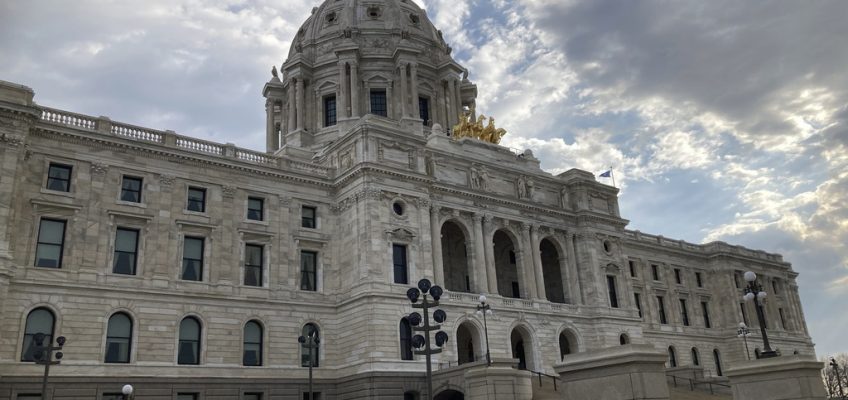Minnesota has thus far stayed out of the “redistricting fight” as states like Texas and California butt heads over potentially gaining more congressional seats ahead of the midterm elections.
The push was prompted by President Donald Trump encouraging Republicans in Texas to redraw their maps, and some blue states, such as California, responding with threats to do the same. Though the effort hasn’t been initiated in Minnesota, Gov. Tim Walz said earlier this month at Farmfest that this isn’t a situation where Democrats can “go high.”
Minnesota Gov. Tim Walz. (AP Photo/Matthew Putney,File)
“We’re not dealing with a normal situation; we can’t on this say, ‘When they go low, we gotta go high,’” Walz said. “When they violate the law and gerrymander, if we don’t do something about this, they are going to game this system, take these votes away, and potentially switch a midterm.”
Minnesota’s eight congressional seats are currently divided between parties. The state is required to redistrict every census year, and the Legislature draws up maps and attempts to pass those maps similarly to how it handles bills.
Since 1980, partisan gridlock in Minnesota’s split Legislature has prevented lawmakers from agreeing on new maps, leaving redistricting to the courts.
“The Democrats write a map that they want, Republicans write a map,” Walz said. “And then the judges say, ‘Oh, isn’t that sweet? Those are gone.’ And they create fair maps.”
Split Legislature
The Minnesota Legislature is currently effectively split. The House is currently split 67-66 with the Republicans at a one-seat advantage. If a DFLer wins a special election for Rep. Melissa Hortman’s seat, the House will return to a 67-67 tie.
David Schultz, professor of political science and legal studies at Hamline University, said Monday that “given how polarized the state is,” he doesn’t see the Legislature agreeing on a new congressional map.
“Essentially, it’s a split Legislature, and it takes 68 votes to pass anything in the House of Representatives,” he said. “I cannot see any situation here where … any Republican would agree to voting for any plans sponsored by the Democrats that would result potentially in the Republicans losing … one or more seats in the House of Representatives.”
Legislative deadlock aside, Schultz said it’s unlikely Democrats could find a new seat to pick up. If anything, it would be the 2nd Congressional District, which is considered the most competitive of Minnesota’s eight seats. U.S. Rep. Angie Craig announced her bid for the U.S. Senate on April 29 , leaving the seat up for grabs come 2026.
Alex Plechash, chair of the Minnesota Republican Party. (Courtesy of the City of Wayzata)
“Maybe you might be able to redistrict in a way that makes the 2nd Congressional District — Angie Craig’s — a little bit safer for Democrats, but I don’t know how you could draw district lines in a way to make Emmer’s or Fischbach’s or Stauber’s or the 1st District certain to be Democrats,” Schultz said. “I mean, the Democratic votes are just not there in those four congressional districts.”
Alex Plechash, chairman of the Minnesota Republican Party, said Thursday he thinks Minnesota has generally managed redistricting well in comparison to other states.
“My sense is that Minnesota is one of the states that actually has handled this pretty well, overall,” he said. “It can get very contentious between the parties. Gerrymandering, of course, is the thing that people fear on both sides, and there have been … extreme examples of gerrymandering in the boundaries to favor one party or the other.”
Plechash said he would support a bill sponsored by Rep. Paul Torkelson, R-Hanska, in the 2025 legislative session to create a bipartisan redistricting commission.
In 2021, after the last census, the state narrowly avoided losing one congressional seat altogether. Schultz said that by 2030, the state of Minnesota may lose a seat if population doesn’t grow faster.
California responding to Texas
Walz hasn’t initiated any plans in Minnesota to redistrict ahead of 2030, but said California is “going to have to respond” to Republican efforts in Texas.
“In this situation, if California is going to have to respond to Texas, they’re going to have to,” he said. “It is bad for democracy, it’s bad for the country, but what’s worse for the country is a totalitarian president who gerrymanders districts in his favor with no response from us.”
Andrew Karch, professor of political science at the University of Minnesota, said Wednesday that even if Minnesota isn’t expected to see its own efforts, Walz’s comments are likely to lend support to his Democratic colleagues.
“A Democratic politician, especially one who has sort of a national profile like Governor Walz, probably wants to lend support to his fellow partisans and express solidarity with what they’re doing,” Karch said. “Even if, in this state, any sort of action is unlikely.”
Related Articles
Maplewood state senator arrested on suspicion of second DWI
Molly Coleman wins Ward 4 seat on St. Paul City Council with 52% of vote
Xp Lee wins primary for Melissa Hortman’s seat; White Bear Lake mayor primary results in
Minnesota could owe IRS nearly $7M over tax benefit error
Gov. Walz names four to fill UMN Board of Regents vacancies


Leave a Reply